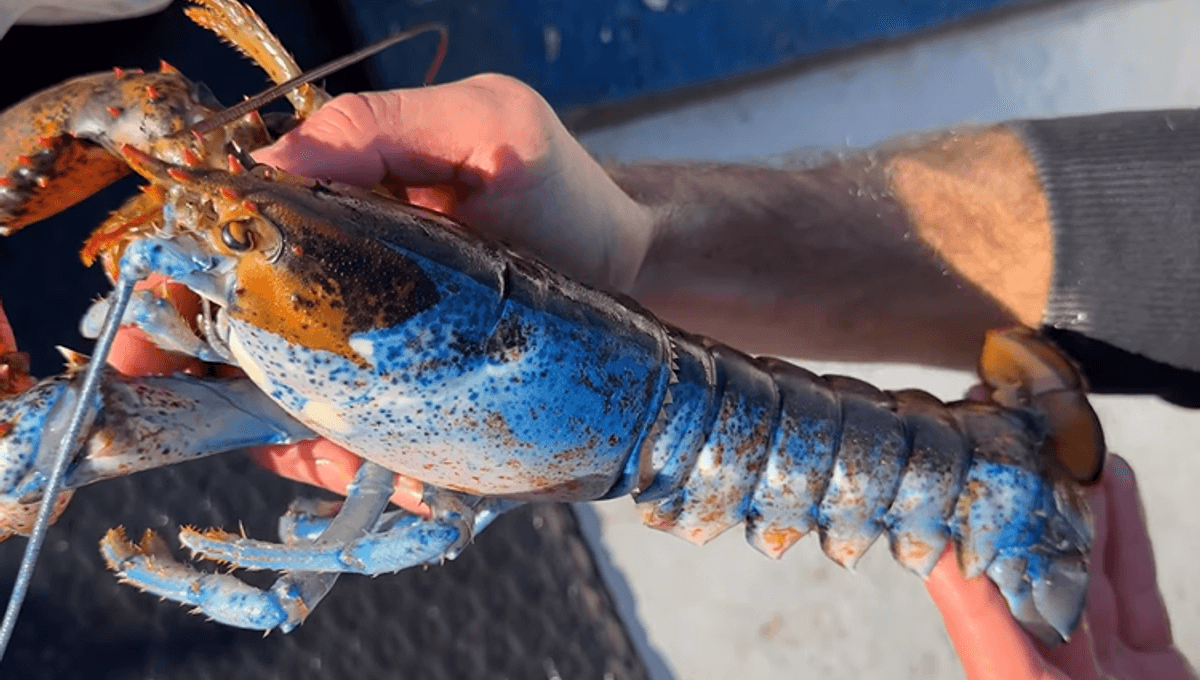
Bowie might just be the rarest lobster in the North Atlantic, if not the world. This special specimen is split directly down the middle, with its left side being a vibrant blue color and its right being a typical orange color. Not only that, but it’s also an example of a bilateral gynandromorph: half-female and half-male, split perfectly down the animal’s midline.
The ultra-rare lobster was recently caught by a friend of Jacob Knowles, a fifth-generation lobster fisherman in Maine, who has a wildly successful TikTok and Instagram channels showcasing the surprisingly fascinating world of catching lobsters.
It’s estimated that blue lobsters are one in 2 million, and bi-colored ones are one in 50 million, which makes Bowie unbelievably rare when you consider that it is also a bilateral gynandromorph.
“This is the coolest lobster I’ve ever seen. Not only is it split 50/50 down its back, blue and normal, but if you look underneath it’s actually half-male and half-female. The blue side is a male, the normal side is female,” Jacob said in a video.
“This lobster, realistically, is the rarest lobster in the Gulf of Maine,” he added in another video.
Jacob asked his followers what they should name the fabulously flamboyant lobster and they aptly voted for “Bowie” in homage to the late, great music icon David Bowie, possibly due to his challening of gender norms or even due to the misconception he had different colored eyes (he actually had anisocoria, meaning one pupil is bigger than the other). Other suggestions included Two-Face, Icy Hot, Lobstery McLobsterface, and Leonardo Da Pinchy.
Bilateral gynandromorphism is when the two halves of the body express different sexual characteristics. It’s a rare condition, but one that has been documented in dozens of species, from birds such as the rose-breasted grosbeak and northern cardinal birds to insects like nocturnal bees and stick insects.
Biological sex is determined by the combination of sex chromosomes. For example, in humans and some other species, males have an X and a Y chromosome, while females have two X chromosomes, though this isn’t the extent of combinations. (In other animals, including insects and birds, sex is determined by the combination of Z and W chromosomes, but we’ll stick to X and Y in this explanation for simplicity’s sake).
Scientists believe the mechanisms behind bilateral gynandromorphism occur during the very early stages of development. As the organism begins to grow, a male XY cell will undergo mitosis and duplicate its chromosomes, becoming XXYY, before dividing into two XY cells. In gynandromorphs, however, this process doesn’t go as planned. Instead of dividing into two XY cells, the cell accidentally divides into an X cell and an XYY cell. If this glitch occurs in the earliest stages of development, it can result in a large portion of the cells being both X and XYY.
Bowie is very much living their best life. After deciding not to return the lobster to the sea, Jacob and the team temporarily held them in a cage at the harbor. However, an unexpected downpour of rain meant the bay became diluted with freshwater, which isn’t good news for a creature used to seawater.
Fortunately, the Oceanarium and Education Center in Bar Harbour came to the rescue, providing Bowie with a tank and helping Jacob to set it up. The lobster seems to be settling in pretty well, happily munching down herring and quietly scuttling around their brand new tank.
You can continue to follow Bowie’s journey on Jacob’s TikTok.
Source Link: Meet Bowie, The Super Rare Half-Male, Half-Female, Half-Blue, Half-Orange Lobster